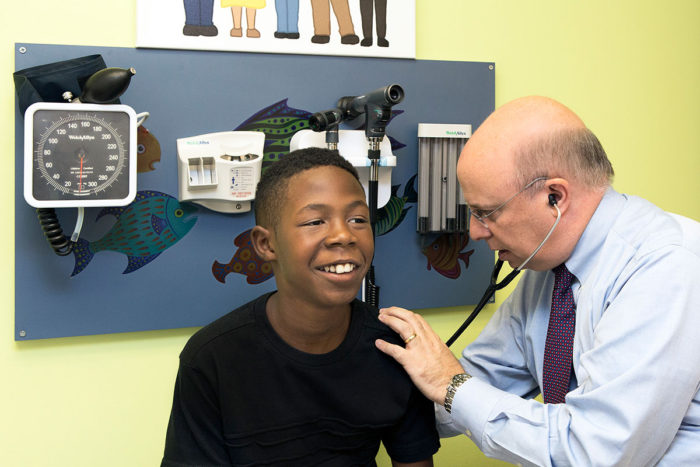Pet, pest allergens linked to reduced asthma risk
Bacteria associated with allergens may play key role
 Michael Worful
Michael WorfulLeonard Bacharier, MD, right, examines Tristan Norris, 11, a participant in an ongoing study aimed at understanding what factors may increase or decrease the risk of developing asthma in childhood.
A new study of children living in inner-city areas and at high risk of developing asthma suggests that exposure to certain pet and pest allergens in infancy lowers the risk of developing asthma by age 7. The research also provides evidence that the type of bacteria hitching a ride on the allergen particles is an important factor in determining asthma risk.
The study also linked the mental health of the mother to a child’s asthma risk, with higher risk associated with mothers scoring higher on measures of depression and stress. As in past studies, maternal smoking during pregnancy also increased the risk of a child being diagnosed with asthma.
The research, published Sept. 19 in The Journal of Allergy and Clinical Immunology, included children living in inner-city St. Louis, Baltimore, Boston and New York City. The Urban Environment and Childhood Asthma study (URECA) is funded by the National Institute of Allergy and Infectious Diseases, of the National Institutes of Health (NIH), through its inner-city asthma consortium. The study was conducted by Washington University School of Medicine in St. Louis, the Boston University School of Medicine, Columbia University, The Johns Hopkins University School of Medicine, the University of California San Francisco, and the University of Wisconsin-Madison.
“This study suggests we may not be focusing on the right targets for preventing asthma in the inner city,” said co-author Leonard B. Bacharier, MD, a Washington University asthma specialist and the Robert C. Strunk Endowed Chair for Lung and Respiratory Research Professor of Pediatrics. “We may not need to worry about making sure the household environment is maximally clean — in fact, it’s possible that could be counterproductive. But helping women manage the challenges of mental health may make a difference.”
Of the 442 children with complete data, 130 (29 percent) had an asthma diagnosis by age 7. The study found that higher amounts of cockroach, mouse and cat allergens measured in house dust during a child’s first three years of life were associated with lower risk of developing asthma.
Children at high risk of asthma included those whose mothers reported having the condition and those with higher levels of a chemical called cotinine measured in umbilical cord blood at birth. A product of the breakdown of nicotine, cotinine measured in umbilical cord blood is a marker of tobacco use during pregnancy. However, smoking before pregnancy or after birth — by the mother or other household members — was not associated with increased risk of asthma in this study. Maternal stress and depression, measured via questionnaires, was significantly associated with increased asthma risk.
Of particular interest, according to Bacharier, was the analysis of the bacteria associated with the allergens, especially the counterintuitive finding that more cockroach exposure was beneficial. According to the data on household dust, high levels of cockroach allergen was the most protective against the development of asthma, followed by mouse and then cat allergens.
“These allergens don’t exist by themselves — bacteria live with them,” said Bacharier, who treats patients at St. Louis Children’s Hospital. “It’s possible that the allergen itself is not the problem. This could help explain data that seem counterintuitive. How can exposure to cockroaches be good for you? If the cockroach allergens happen to come with bacteria that are helpful, then you end up being protected. This suggests whole new avenues of studies looking at the household dust microbiome as well as the human microbiome and their interactions in the development of asthma.”
In households where children developed asthma, the bacteria associated with house dust tended to be microbes that cause disease, or their close relatives. In contrast, households where children did not develop asthma tended to have bacteria that have shown evidence of protecting against respiratory problems.
Because this study was observational, Bacharier said researchers can’t say whether certain bacteria or allergens cause or prevent asthma. But the data do point to new areas of research to pursue in determining what leads to the development of asthma in early life and what can be done to prevent it.






